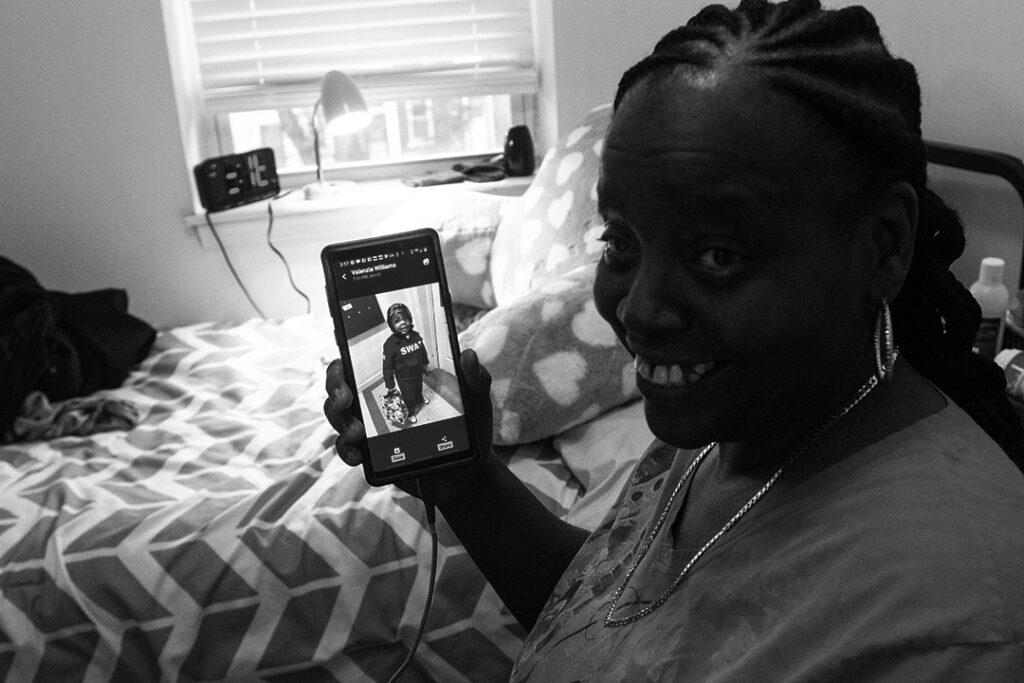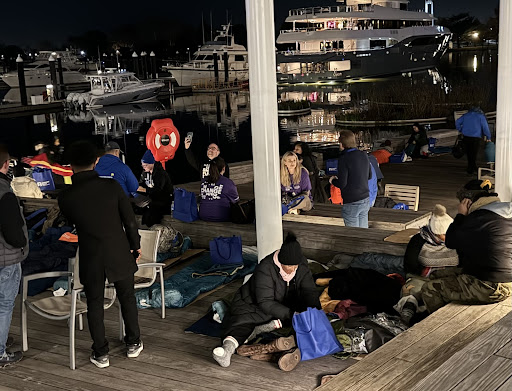In January 2021, days after the insurrection, I moved to D.C. to study film. Driving into the city felt like a scene from a movie. D.C. was on a double lockdown, and there were armored trucks flanking the entrance from the highway into the city.
I previously studied economics at the University of Amsterdam, in the Netherlands. Back then, I lived above Albert Heijn, a local supermarket, and was often greeted there by a man with a toothless smile inviting me to buy Z! — a newspaper run by people experiencing homelessness. Growing up in Pakistan, I had a specific perspective on poverty, and hearing his experience in the west was new to me.
I ultimately specialized in human development economics, guided by brilliant and practical Professor Jacques van der Gaag. After graduating, I worked to craft stories with international and humanitarian organizations to galvanize resources and action for good. Now I was in D.C. at American University, trying on a different lens. I wondered what it would be like to live in the home of such an immense global power.
I took a photojournalism class with the great Professor Bill Gentile. An esteemed war photographer, he brought grit and high expectations to our training. He took us to the streets to find our stories. I loved walking around D.C.; the avenues were wide and tree-lined, the neighborhoods bursting with food, art and music. But poverty cut through this pristine image sharply.
In 2022, D.C.’s Point-in-Time (PIT) Count showed 4,410 people experiencing homelessness in a single night. While this is the lowest number seen in 17 years, progress has been slow. Experts say this number is a gross underestimation. To my surprise, even steps from the White House lawn, people without homes staked their tents in protest, suffering silently in plain view of the politicians. The juxtaposition of the two confused me, and I sought to learn more.
I meet Jet, 53, in Dupont Circle one afternoon early December. We’re introduced through Street Sense, a street paper with a mission to end homelessness, for which she writes and sells. We sit on a bench together, and share delicious Krispy Kreme donuts. She hasn’t been back since she stopped sleeping here regularly, three years ago. It’s a busy day in the park.

“It was like living in a glass menagerie. Everybody on the outside, constantly looking in,” she says.
Jet observes the world. She is vibrant, positive, and eloquent. We love the same classic rock bands — the Doors, Fleetwood Mac. She often pauses during her stories to point out memories — where she and her pomeranian Bella slept, where she panhandled, what someone said to her once, “I’m glad I’m not homeless, I couldn’t do that. Why don’t you work?”
Jet used to work as a political strategist and telemarketer. She also studied acting at Duke Ellington High School. She tells me how to close a sale.
“You become the person you’re selling to. Give them a bit of themselves, and you’ve got a sale.”
Jet, charming and great at her job, was beginning to enjoy life after a tough youth. Growing up in Northeast D.C., Jet’s mother was a heroin addict, which led to dangerous situations, eventually landing her in and out of the foster care system. She had worked hard on turning her life around.
It all changed when she was hit by a car in 2016. Jet received a small cash settlement, but was laid off soon after from her job as a telemarketer, when her company closed during Trump’s presidency. She faced a series of health issues and challenges with getting unemployment. Slowly buried in medical bills, she became unable to afford rent. Finally, when Jet’s roommate became violent, she moved out of yet another dangerous situation. Jet’s family turned their nose up at her because she is gay, and she eventually found herself without a place to live.
“I remember the first time. I was sitting with a friend outside Duane Reade, clutching my pearls as she asked for money.” Jet was aghast at the idea of panhandling.
D.C.’s Mayor Muriel Bowser has allocated $31 million towards ending chronic homelessness through funding Permanent Supportive Housing vouchers in the 2023 budget. President Joe Biden aims to reduce homelessness in the U.S. by 25% in 2025. While these are positive developments, housing services are currently met with confusion — processes are rigid, complex and cumbersome.
Jet speaks of the generosity of churches and organizations like So Others May Eat (SOME) and Bread for the City. Bread for the City provides food, clothing, medical care, and legal and social services to D.C. residents living with low income. A “one stop shop,” if you will. I visited their location in Shaw and am astounded by their scale, speed and efficiency. Big-hearted Willette shows me the food distribution center, where between 500 to 1000 bags of food are distributed each day. Willette hugs a client as she offers her two bags of food for a family of four. This client is a regular, and Willette’s worked here for nearly a decade. During the pandemic, the number of people needing food doubled, and Willette’s shifts went late into the night. She loves her job, and finds the work she did during the pandemic especially rewarding. “I remember what it feels like to be on the other side.” Poverty is closer than you think.
“We’re all one paycheck away from being homeless!” Jet says.

Across the country, people are being priced out of their homes because of the voracious appetite of capitalist forces. Furthermore, the short-sighted stigma of the low-income housing market in the real estate business prevents realistic and holistic societal needs from being met. The result? A constant shortage of affordable homes.
But the problem stems much deeper. In D.C., Black women make up 75% of women who are homeless, whereas they make up only 52% of adult women. The majority of the women I spoke to shared similar themes of poverty and abuse, which led to trauma, depression, mental illness and drug addiction.
I meet Anita, 64, at New Endeavors by Women (NEW), a nonprofit that supports women and children with housing and case management. I wanted to find a safe space, and NEW was just that. We sit in a quiet living room of a four-bedroom apartment.

Anita is a gentle and personable soul. A former bus driver, her favorite part of working was interacting with people. Anita started using drugs in the 1980s. This was the beginning of the crack epidemic, which led to disastrous public health consequences.
“My whole family is addicted. Even my grandmother, back in the day.”
Why? I ask.
“Depression. It numbs the pain.”
It is not hard to see the cause of depression, when the trauma of poverty is enough to cause that, not to mention the erosion of social fabric it causes when ignored.
“You can’t treat the addiction, if you don’t treat the trauma,” Anita tells me.
In 1995, Anita was diagnosed with a chronic illness, and has since been battling multiple medical issues. She relapsed four times, the last time when her mother passed away. NEW provided Anita shelter, a little over three years ago. It took her 10 months for the paperwork to come through. In the meantime, she slept on her boyfriend’s mother’s couch. For people trying to get out of a bad situation, waiting adds to frustration and fear of relapse.
Getting housing is a complex, time-consuming process — there is no easy A to Z of how to get out of homelessness.
As we wrap our conversation, Anita shows me photos of her 3-year-old grandson Jackson, beaming with pride, dressed as a SWAT agent for Halloween. A consistent case worker, therapist, sponsor and her place at NEW means she finally has stability and feels safe, so she can focus on her future.
“You can’t treat the addiction, if you don’t treat the trauma,” Anita says. “The system is designed for you to fail.”
It’s not just about bad crowd or bad luck, Moira, communications manager at NEW reminds me, as we walk out of the shelter. This housing crisis is, simply put, the direct result of decades of structural racism resulting in negligent policy and planning, where the vulnerable in an economy are not seen as a priority. The housing crisis in the capital shows, in a microcosm, the vast spectrum of structural issues that need to be addressed in the United States.

There is an immediate need for more resources, more trauma-informed support, more outreach, clearer information on shelter and housing processes, a reduction of the burden of bureaucracy, and a desperate need for flexibility. There are a million ways to become homeless, and therefore a care-driven, innovative and multi-pronged approach is necessary to get people out of homelessness, and permanently out of the poverty trap. As there are radically different ways to become unhoused, there must be radically different solutions out.
As a community, small actions can make a difference. For instance, during my interview, students from George Washington University came to drop off hygiene kits. There are incredible volunteer programs available in D.C., such as with NEW and Bread for the City. As Moira and I say goodbye, she invites me to Back on my Feet, a morning running club helping with building routine and work placement for people experiencing homelessness. The work doesn’t stop, and everyone does their part.
I had wondered what it would be like to live so close to the seat of power, yet here on the street I was proximate to the powerless, and reminded how poverty prevails in so many ways when you have the odds stacked against you.
Jet now lives in her grandmother’s home — the home she grew up in. However, yet again, Jet is facing a dangerous situation, this time where the bank is trying to reclaim her home. It never stops.
It’s dusk now; Jet and I sit on the steps of a building overlooking Dupont Circle, a corner where Jet and Bella often used to sleep at night. Above the hustle and bustle of the busy square, she reflectively gestures,
“We used to call this spot the Stage. We were invisible. But we’d look down at the people passing by and think: you could be me, and I could be you.”

Anya Raza is a writer, filmmaker and economist, based between New York and Islamabad. Connect with her on @anyarazaofficial on Instagram.








